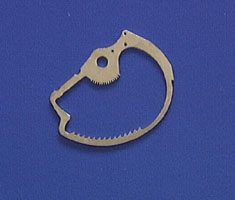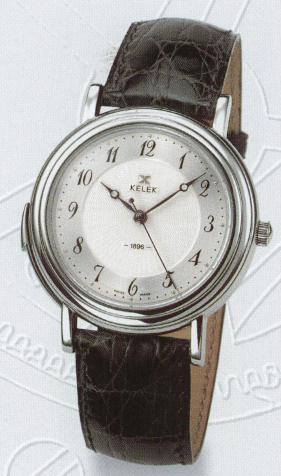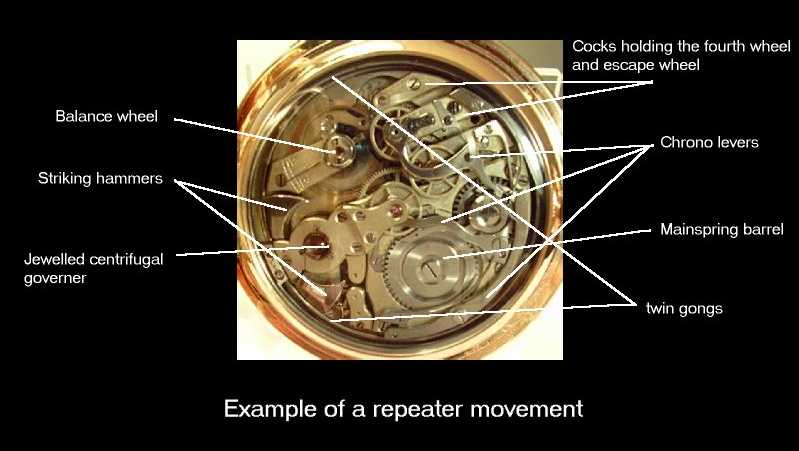
Picture shows the minute rack of the repeat mechanism. Note the 14 teeth of the rack, each representing one minute.

The repeater is a very important complication to the basic timekeeping duties of a watch. Other important complications include the perpetual calendar, the chronograph, the tourbillon, amongst lesser complications like power reserve indication, double barrels, dual train, jumping hours, retrograde indications, date calendars, dual timezones, et al. This article will provide some information on the repeater.
As a result of the extremely complicated nature of the repeat mechanism, these watches are typically very expensive. Miniaturization for a wristwatch makes the mechanism even more complicated, and consequently, repeating wrist watches are much more expensive than their pocket watch variants.
Almost all major manufacturers feature a repeater. Patek Philippe, Audemars Piguet, IWC, Jaeger LeCoultre, and interestingly the firm of Kelek who makes some of the most cost effective repeaters for wristwatches. All the others have very high end pieces, with equally high price tags.
Historically, before the advent of the electric light or luminous material, the only way to tell the time at night, was either to light a candle/lamp, which was bothersome, or to wait in anticipation for the clock's striking mechanism.
The idea of incorporating a strike mechanism struck (pun intended) Daniel Quare, an English watchmaker, who was awarded the patent in late 17th century. The initial development was a little slow, because Quare was not an extremely competent watchmaker. Abraham Breguet himself provided the final significant improvement of using wire gongs instead of bells. You must remember, that in Quare's days, watches were fairly large, and could be built to incorporate the strike mechanism, and the bells.
The heyday of repeaters was from the early to mid 19th century, with the art peaking about the time of the first World War. The Swiss made thousands of ebauche style repeaters, and one particular firm worthy of note is Le Phare, famed for its well designed, well made repeaters, often unsigned.
Many of these wonderful timepieces were made even more complicated by the addition of chronographs, either split second or othewise, calendars, perpectual or othewise, and othe complications. By the early 1920s, the electric light was becoming popular, and the young of the day found that the extremely high skills required to make a repeater too demanding.
The genre belongs to a larger catagory of watches with striking mechanisms. The striking mechanism will allow the watches to tell the owner the time by chiming a series of strikes. Two distinct catagories exist:
Again, two fairly large catagories:
Other variations exist in the form of half quarter repeater, five minute repeaters. Another variation of the watches with strike mechanisms, are carrilons or clock-watches, which Dumb repeaters are also found, in which the hammers strike a block of metal attached to the case, and allows the owner to feel the strikes. How does it workA repeat mechanism is an extremely complicated series of racks and snails to read the time shown by the hands, a mainspring system wound by pressing a button or a slide on the case to activate the on-demand repetition, a centrifugal force regulator which governs the rate in which the blows strike, the hammer system and typically two wire gongs (one high pitched, and the other low pitched) circumventing the movement. The actual working of the mechanism is beyond the scope of this article, and there are many excellent books on this subject. One recommended reading is Reinhart Meis' "Pocket Watches - From Pendant Watches to the Tourbillon". |  The Kelek minute repeater: note the slide at side of case near 9 o'clock. The repeater will strike, on-demand, when the user pushes this slide upwards, winding the repeat mainspring, and releases it. |
Here is a picture of a pocket watch repeater, showing the main parts:

Three notes:
1. This particular example also incorporates a chronograph, whose levers are labelled.
2. The plates are nickle plated, with proper anglage, and well polished, indicating a high quality movement. Note also
that the movement is jewelled to the hammers.
3. The racks, snail are hidden under the dial, and not visible in this illustration.
As repeaters are extremely complicated devices, one should always buy with caution. Repairs are extremely expensive, if you can find a competent watchmaker. Here are some pointers:
I'll leave you with a picture of repeater hammers:

 Go back to home page
Go back to home page